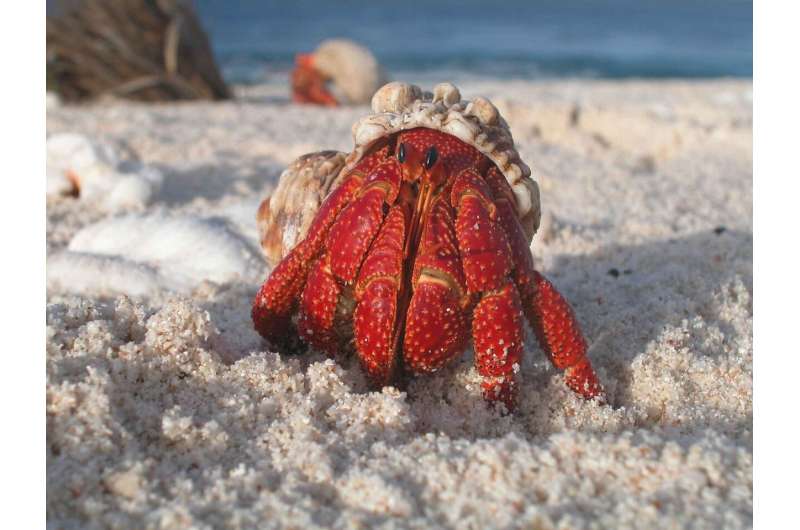Competing crabs don't fight over 'homes'

Two hermit crab species which live on the same beach have adapted to coexist by selecting differently shaped shells as their homes, according to a study in the open access journal BMC Ecology.
When closely-related species occupy the same habitat, competition for essential resources such as food and shelter can occur. Previous research suggests that rather than compete, some species may have adapted to coexist by splitting limited resources. This hypothesis is difficult to study as most animals are not limited by a single resource.
To investigate how resource division occurs and whether it may be a driver of coexistence between competing species, Sebastian Steibl and Prof Dr. Christian Laforsch from the University of Bayreuth, Germany studied two hermit crab populations, Coenobita rugosus and C. perlatus, both found to inhabit the same beaches of 11 coral islands across the Republic of Maldives.
Sebastian Steibl, lead author of the study said: "The high overlap of the two species across the same beaches suggests that they are not limited by competition over habitat. Competition over a food source can also be excluded, as previous studies have shown both species to have no clear food preference. We concluded that the survival of shell-dwelling hermit crabs is limited under natural conditions by the availability of empty shells only, which are needed for shelter and protection against predators, and that they would therefore be a suitable example of two potentially competing species to study."
For each of the two species, 150 hermit crabs occupying various shells were collected from the beaches of the island of Naifaru, along with a variety of 150 empty shells. The crabs were removed from their original shells and presented with two new empty shells of different shapes, both suitable for their size. After one hour, the preference of each crab was noted.
The authors found that although both species naturally co-inhabit the same beaches, they displayed a preference towards different shell types. C. rugosus preferred short, spherical shells, while C. perlatus preferred elongated shells with a narrow opening.
Steibl said: "The shells used in our study showed no striking variations in colour or pattern, but generally appeared pale and smooth. This suggests that the hermit crabs did not make a choice based on individual shell species, but the overall shape and structure of each shell."
Steibl added: "These preferences may reflect different survival strategies developed by each species in response to environmental pressures. Further research is needed to investigate why the different species evolved separate behaviours when facing the same stressors, but we know that heavy, narrow shells decrease the risk of predation but limit clutch size and require more energy to transport. Lighter, round shells allow for greater clutch sizes, are easier to move around and are more suitable for burrowing, but increase susceptibility to predation."
The findings suggest that because the two hermit crab species are no longer in competition for the same limited shell resource, they are able to coexist in the same habitat. Natural hermit crab populations present an ideal model system to further study theories on resource partitioning and evolutionary differentiation over time between closely-related species, according to the authors.
More information: Shell resource partitioning as a mechanism of coexistence in two co occurring terrestrial hermit crab species, BMC Ecology (2020). DOI: 10.1186/s12898-019-0268-2
Journal information: BMC Ecology
Provided by BioMed Central

















